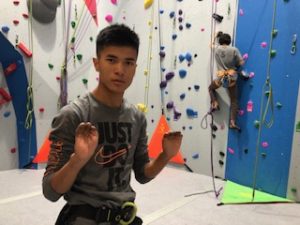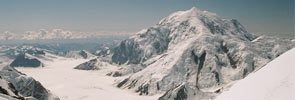Dawa “Sange” Sherpa
Multiple surgeries performed throughout 2017 and 2018
Bilateral Hand Reconstructions
Update (2/2019): Sange has returned to Nepal and is looking forward to guide once again.
 About Sange
About Sange
I was born in Nepal on September 15, 1998, in a very remote village near Makalu, the fifth highest mountain on earth. Makalu is not as popular with tourists as the Sankhuwasabha, and even today my village – Bungime, 03, Makula – remains very isolated and undeveloped. My father is a farmer and when I was 6 years old I was working herding yaks in the mountains. It is very hard to take care of animals without help from anyone, even parents. I would sleep in the yak house by myself at night. My friends could go to school every day, but I had to work. There was a very informal learning center near our village, but I could only go to school 3 or 4 days a month because I had to work. When I was 14 years old, my mom got very sick and after a few months she passed. My life then became more difficult because I had to now take care of my 5 younger siblings. I decided I needed to do different work for better life for me and better education for my siblings. I left my village and went to our capitol city, Kathmandu, to look for work. When I was a child, I could see the towering mountains visible from my village. I remember when I was eight or nine years old, I heard stories about the successful summits of the high mountains by very brave men. I would also hear about the sherpas. In my heart, I would tell myself that one day I would also be a mountain climbing guide. Once in Kathmandu, I thought I could realize this dream and I started working as a porter on high altitude trekking trips in the Himalayas. I liked meeting people from different countries and helping them have good experiences in Nepal. It was also difficult work and at times I cried, but I was making more money for my family. My friends and trekkers on many occasions lost their limbs due to frost bites and I helped them get to safer places. The trouble did not diminish my determination. I had worked many times, first as a porter, and then as a guide in the Everest region, Mustang, Dolpo and the Annapurna Circuit. After a few years I had been to more areas and began to see more mountaineering in Nepal. I had to train myself and gain knowledge about the rugged mountains and the difficult trails if I were to become a successful mountaineer. I worked hard and many were impressed by my agility and sincerity. I made friends in the industry and grabbed every opportunity I could get. I left all fear behind.
Career Background
I took a NATHM Guide Training Course and got training at the Khumbu Climbing Center in Phortse and from the International Snow Training Academy. But mostly I gained experience on 6000m peaks. From 2015-2017, I summitted Lobuche 10 times; Island peak 7 times, and a few other mountains below 6000m. All these seemed impossible for me once, but I lived with my childhood dream every day and night. I first worked on Everest in 2016, carrying loads and on a team of mountain rescuers. Once, I along with other friends rescued 2 mountaineers stranded at camp III on Mount Everest. When we came to base camp one of them said, “I have all the riches in the world, but you rescued me when I had prepared myself to die in loneliness. You do not know that not only you have saved my life but in you I have seen true God.” He could not hold his tears in happiness. That day I felt I had accomplished something real in life, the feeling was more overwhelming than climbing all those mountains.”
Treatment Procedure and Recovery Plan
In May 2017 I guided a client to the summit of Mt Everest and then had an unfortunate experience. Remembering what the rescued man said to me the year before and because of my duty as a Sherpa, I would not leave my client, even though I knew we should turn back but he would not listen to me. I gave him my oxygen and we summitted after many hours, but we both collapsed at the Balcony during our descent in a storm. We were rescued from 27,300’. My client was able to walk, but I was unconscious and most of my body was frozen. People had passed me and thought I was dead. I am told word had spread to my friends that I was dead. Thanks to a group of Sherpas that found a faint pulse in my body, they dragged my frozen body down to Camp IV. There an American doctor made me comfortable in a tent, but she thought that I probably would not live. When I did begin to wake up, I could not move any part of my body and at first I did not know if I was dead or alive. I was then helicoptered to a hospital in Kathmandu. I started to recover, but had very serious frostbite on my hands. Because my rescue was the highest ever on Mt Everest, there was a lot of publicity and a Sherpa in the United States learned of my misfortune and contacted me in Nepal. I did not have help from my companion and the doctors said they could not save my hands. My new ‘Achu’ in the United States knew that there might be better medical care and resources in the United States. He also knew about the Kees Brenninkmeyer Foundation and the help they give to injured mountaineering guides. He helped me apply to the foundation for medical treatment and then helped me get a visa to come to the United States. All of this took about 3 months, not because of Kees Brenninkmeyer Foundation, but because getting a visa was very difficult. I arrived in the United States in August 2017 and had my first surgery the next day. I underwent many surgeries to take bone and skin from other parts of my body to make new fingers and thumbs to give me pinch and grasp function. Since my body had been frozen, my circulation was not good and I also got a serious infection after my first two surgeries. My treatment became more complicated and took longer than originally planned, but the Kees Brenninkmeyer Foundation stuck with me through all of the setbacks, committed to my returning to the life and work that I love. I had never had so much help, financial support and encouragement in my entire life. I have had to learn many new things, including how to use my new hands. At times I miss my old hands, but I know that I am very blessed to be alive and to have the hands I have today.
Testimonial

"I cannot find perfect words to explain how thankful I am for all the assistance I received from the Kees Brenninkmeyer Foundation, Without the foundation's support, I probably would have had my hands cut off in Nepal and maybe I would have died from infection. Because of this foundation, I was able to come to the United States and have both my hands treated by Dr. Viola at The Steadman Clinic in Vail. All of my fingers and most of my thumbs had to be amputated. I returned to Nepal on December 25, 2018, after 16 months of treatment in Vail, CO. I returned feeling very grateful, strong and ready for the next chapter of my new life. My hands are scarred and look very different than before my incident, but I can use them very well. I just have to be careful about future frostbite. I can tie into a climbing harness; my legs and the rest of my body are now very strong again and I just learned to ski. While I was getting medical treatment, I learned more English, how to use a computer and met many great people. I will use these new skills to continue learning and to develop my business. My future is very good because the Kees Brenninkmeyer Foundation made it possible for me to get the best possible medical treatment. Their support has helped me to believe in myself and to know I can support myself and my family. THANK YOU to everyone with the Kees Brenninkmeyer Foundation for all that you have done for me! I promise to honor your investment in me by becoming the very best that I can and hopefully someday I can give back to help others in the spirit that you have helped me. "
- Dawa “Sange” Sherpa

